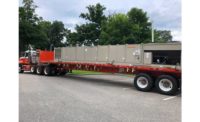Many schools are returning to a situation closer to traditional attendance, with students going to a designated building for several hours each day. This means dealing with an issue many avoided last year — snow removal. Fortunately, radiant heat systems exist to help.
Many schools already use radiant heat systems to provide heat, said Ryan Westlund, senior manager of radiant heating and cooling for Rehau. That makes them ideal for expanding that system outside. The most common areas of concern for schools are walkways, entrances, and drop-off areas.
Rehau provides radiant heat solutions by circulating a water-based medium through a network of PEX pipe embedded in the surface. Other providers offer an electric resistance solution. Using either heating source has the same basic results.
Schools want to eliminate snow in areas with high foot traffic to avoid students suffering slips and falls, Westlund said. There are also benefits when it comes to facility maintenance. Not having to scrape these areas with shovels or plows makes the concrete last longer.
Avoiding Exposure to Chemicals, Noise
The alternative for snow removal is chemicals or salt, which can be detrimental to the landscapes and hardscapes of campuses. As students track these agents inside, they cause damage to the floors. Using radiant heat instead prevents this damage.
Westlund said there is also growing concern about exposing young children to chemicals. This includes refrigerants, which make hydronic and other radiant heat systems more appealing to school administrators. This is a growing concern in places such as Southern California, an area where Westlund said they are seeing growth in the hydronic market despite the moderate temperatures.
“In discussions where it came down to two systems of similar cost being able to supply the same amount of thermal comfort, both at very good energy points, it was the tipping point,” he said.
Another growing concern for school is noise. Studies have found that students perform better in a quieter atmosphere. Teachers also prefer a less noisy environment so they can deliver lectures without having to raise their voices. Rehau promotes the lower noise levels of radiant heat over a traditional HVAC system that can produce considerable sound each time a heating cycle starts.
Different Levels of Education Require Different Levels of Snowmelt
There are two tiers in the education market for snowmelt. One is the K-12 market. The other is higher education. Each has specific requirements.
The K-12 schools only need snowmelt during certain hours. Also, they will close if there is too much snow. This means systems don’t have to be designed to keep up with the complete snow load during a bad storm.
“If you can’t get into a parking lot at a K-12, does it really matter that your sidewalk in front of the entrance is not quite able to keep up?” Westlund said.
Colleges and universities are expected to operate almost all the time. This means keeping up with higher snow loads. It also means starting the ice melts at different times. For K-12 schools, that time is dawn. On a college campus, it would be 2 a.m., as students are still returning to their dorms from study groups and other locations.
A college campus has the advantage of using district heating. This means a central source distributes water and glycol to several different locations. This process minimizes mechanical equipment in each building, minimizing clutter and making it easier for the campus physical plant to maintain the heating systems.
“We just have to be aware of how the occupants are using the campus,” Westlund said.
It helps that ASHRAE updated its guidelines for snowmelt a few years ago, said Westlund. They hadn’t been touched since the end of the last century. He said the new guidelines are more practical and include a list of different applications.





